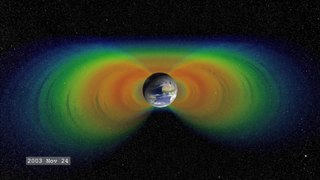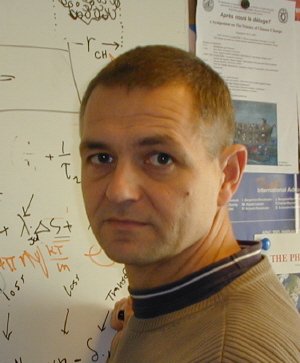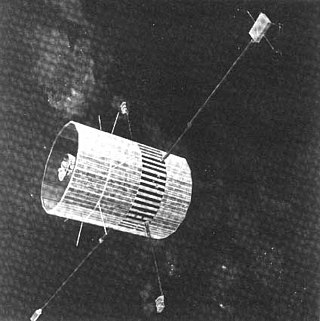
Cosmic rays or astroparticles are high-energy particles or clusters of particles that move through space at nearly the speed of light. They originate from the Sun, from outside of the Solar System in our own galaxy, and from distant galaxies. Upon impact with Earth's atmosphere, cosmic rays produce showers of secondary particles, some of which reach the surface, although the bulk are deflected off into space by the magnetosphere or the heliosphere.

Van Allen radiation belt is a zone of energetic charged particles, most of which originate from the solar wind, that are captured by and held around a planet by that planet's magnetosphere. Earth has two such belts, and sometimes others may be temporarily created. The belts are named after James Van Allen, who is often credited with their discovery.
Ionizing radiation (US) (or ionising radiation [UK]), including nuclear radiation, consists of subatomic particles or electromagnetic waves that have sufficient energy to ionize atoms or molecules by detaching electrons from them. Some particles can travel up to 99% of the speed of light, and the electromagnetic waves are on the high-energy portion of the electromagnetic spectrum.

The Fermi Gamma-ray Space Telescope, formerly called the Gamma-ray Large Area Space Telescope (GLAST), is a space observatory being used to perform gamma-ray astronomy observations from low Earth orbit. Its main instrument is the Large Area Telescope (LAT), with which astronomers mostly intend to perform an all-sky survey studying astrophysical and cosmological phenomena such as active galactic nuclei, pulsars, other high-energy sources and dark matter. Another instrument aboard Fermi, the Gamma-ray Burst Monitor, is being used to study gamma-ray bursts and solar flares.
In astroparticle physics, an ultra-high-energy cosmic ray (UHECR) is a cosmic ray with an energy greater than 1 EeV (1018 electronvolts, approximately 0.16 joules), far beyond both the rest mass and energies typical of other cosmic ray particles.

A gamma-ray spectrometer (GRS) is an instrument for measuring the distribution of the intensity of gamma radiation versus the energy of each photon. The study and analysis of gamma-ray spectra for scientific and technical use is called gamma spectroscopy, and gamma-ray spectrometers are the instruments which observe and collect such data. Because the energy of each photon of EM radiation is proportional to its frequency, gamma rays have sufficient energy that they are typically observed by counting individual photons.

Helios-A and Helios-B are a pair of probes that were launched into heliocentric orbit to study solar processes. As a joint venture between German Aerospace Center (DLR) and NASA, the probes were launched from Cape Canaveral Air Force Station, Florida, on December 10, 1974, and January 15, 1976, respectively.

Advanced Composition Explorer is a NASA Explorer program satellite and space exploration mission to study matter comprising energetic particles from the solar wind, the interplanetary medium, and other sources.
Elastic scattering is a form of particle scattering in scattering theory, nuclear physics and particle physics. In this process, the internal states of the particles involved stay the same. In the non-relativistic case, where the relative velocities of the particles are much less than the speed of light, elastic scattering simply means that the total kinetic energy of the system is conserved. At relativistic velocities, elastic scattering also requires the final state to have the same number of particles as the initial state and for them to be of the same kind.
A Forbush decrease is a rapid decrease in the observed galactic cosmic ray intensity following a coronal mass ejection (CME). It occurs due to the magnetic field of the plasma solar wind sweeping some of the galactic cosmic rays away from Earth. The term Forbush decrease was named after the American physicist Scott E. Forbush, who studied cosmic rays in the 1930s and 1940s.

Henrik Svensmark is a physicist and professor in the Division of Solar System Physics at the Danish National Space Institute in Copenhagen. He is known for his work on the hypothesis that fewer cosmic rays are an indirect cause of global warming via cloud formation.

The Solar Anomalous and Magnetospheric Particle Explorer was a NASA solar and magnetospheric observatory, and was the first spacecraft in the Small Explorer program. It was launched into low Earth orbit on 3 July 1992, from Vandenberg Air Force Base aboard a Scout G-1 launch vehicle. SAMPEX was an international collaboration between NASA and the Max Planck Institute for Extraterrestrial Physics of Germany. The Solar Anomalous and Magnetospheric Particle Explorer (SAMPEX) is the first of a series of spacecraft that was launched under the Small Explorer (SMEX) program for low cost spacecraft.
Health threats from cosmic rays are the dangers posed by cosmic rays to astronauts on interplanetary missions or any missions that venture through the Van-Allen Belts or outside the Earth's magnetosphere. They are one of the greatest barriers standing in the way of plans for interplanetary travel by crewed spacecraft, but space radiation health risks also occur for missions in low Earth orbit such as the International Space Station (ISS).
Spaceship Earth is a network of neutron monitors designed to measure the flux of cosmic rays arriving at Earth from different directions. All the 12 member neutron monitor stations are located at high latitude, which makes their detecting directions more precise, and their energy responses uniform. Their combined signals provide a real-time measurement of the three-dimensional distribution of cosmic rays, mainly galactic cosmic rays as well as solar energetic particles during the most intense solar events. Analyses of these data have applications in space weather studies.

John Alexander Simpson was an American physicist and science educator. He was deeply committed to educating the public and political leaders about science and its implications, most notably as a principal founder of the Bulletin of the Atomic Scientists and a long-time member of the organizations Board of Sponsors.

Scott Ellsworth Forbush was an American astronomer, physicist and geophysicist who is recognized as having laid the observational foundations for many of the central features of solar-interplanetary-terrestrial physics, which at the time was an underdeveloped field of study. In 1937 Forbush discovered the Forbush Effect: an occasional decrease in the intensity of cosmic rays as observed on Earth that is caused by the solar wind and its interaction with the magnetosphere. Scott conducted most of his research during his career at the Department of Terrestrial Magnetism (DTM) of the Carnegie Institution of Washington where he was appointed chairman of a section on theoretical geophysics in 1957. Forbush used statistical methods in analyses of magnetic storms, solar activity, rotation of the Earth, and the rotation of the sun, and the correlation of this geophysical and solar phenomena with temporal variations of cosmic-ray intensity.

In solar physics, a solar particle event (SPE), also known as a solar energetic particle event or solar radiation storm, is a solar phenomenon which occurs when particles emitted by the Sun, mostly protons, become accelerated either in the Sun's atmosphere during a solar flare or in interplanetary space by a coronal mass ejection shock. Other nuclei such as helium and HZE ions may also be accelerated during the event. These particles can penetrate the Earth's magnetic field and cause partial ionization of the ionosphere. Energetic protons are a significant radiation hazard to spacecraft and astronauts.

Cosmic Ray Subsystem is an instrument aboard the Voyager 1 and Voyager 2 spacecraft of the NASA Voyager program, and it is an experiment to detect cosmic rays. The CRS includes a High-Energy Telescope System (HETS), Low-Energy Telescope System (LETS), and The Electron Telescope (TET). It is designed to detect energetic particles and some of the requirements were for the instrument to be reliable and to have enough charge resolution. It can also detect the energetic particles like protons from the Galaxy or Earth's Sun.

Explorer 47, was a NASA satellite launched as part of Explorer program. Explorer 47 was launched on 23 September 1972 from Cape Canaveral, Florida, with a Thor-Delta 1604. Explorer 47 was the ninth overall launch of the Interplanetary Monitoring Platform series, but received the launch designation "IMP-7" because two previous "Anchored IMP" flights had used "AIMP" instead.
A Ground Level Enhancement or Ground Level Event (GLE), is a special subset of solar particle event where charged particles from the Sun have sufficient energy to generate effects which can be measured at the Earth's surface. These particles are accelerated to high energies either within the solar atmosphere or in interplanetary space, with some debate as to the predominant acceleration method. While solar particle events typically involve solar energetic particles at 10–100 MeV, GLEs involve particles with energies higher than about 400 MeV.















